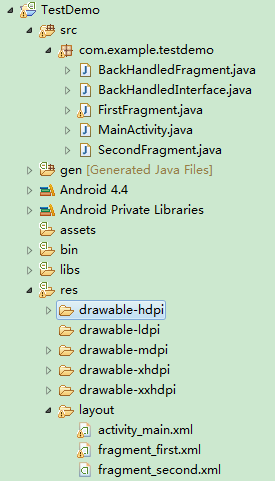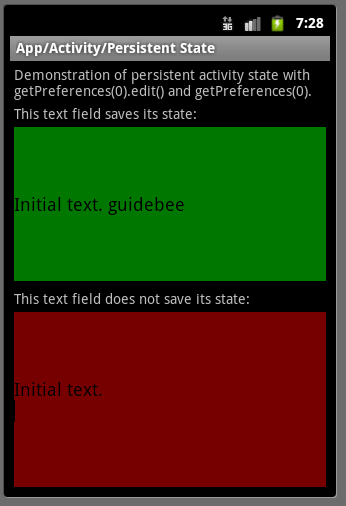編輯:Android開發實例
本文實例講述了Android編程使用Fragment界面向下跳轉並一級級返回的實現方法。分享給大家供大家參考,具體如下:
1.首先貼上項目結構圖:

2.先添加一個接口文件BackHandledInterface.java,定義一個setSelectedFragment方法用於設置當前加載的Fragment在棧頂,主界面MainActivity須實現此接口,代碼如下:
package com.example.testdemo;
public interface BackHandledInterface {
public abstract void setSelectedFragment(BackHandledFragment selectedFragment);
}
3.定義一個抽象類BackHandledFragment繼承自Fragment,後面跳轉的Fragment界面都要繼承自BackHandledFragment。抽象類BackHandledFragment中定義一個返回值為boolean類型的onBackPressed方法,用於處理點擊返回按鍵(物理Back鍵)時的邏輯,若該方法返回false,表示當前Fragment不消費返回事件,而由Fragment所屬的FragmentActivity來處理這個事件。代碼如下:
package com.example.testdemo;
import android.os.Bundle;
import android.support.v4.app.Fragment;
public abstract class BackHandledFragment extends Fragment {
protected BackHandledInterface mBackHandledInterface;
/**
* 所有繼承BackHandledFragment的子類都將在這個方法中實現物理Back鍵按下後的邏輯
*/
protected abstract boolean onBackPressed();
@Override
public void onCreate(Bundle savedInstanceState) {
super.onCreate(savedInstanceState);
if (!(getActivity() instanceof BackHandledInterface)) {
throw new ClassCastException(
"Hosting Activity must implement BackHandledInterface");
} else {
this.mBackHandledInterface = (BackHandledInterface) getActivity();
}
}
@Override
public void onStart() {
super.onStart();
// 告訴FragmentActivity,當前Fragment在棧頂
mBackHandledInterface.setSelectedFragment(this);
}
}
4.主界面MainActivity要繼承FragmentActivity才能調用getSupportFragmentManager()方法來處理Fragment。MainActivity還需重寫onBackPressed方法用來捕捉返回鍵(Back Key)事件,代碼如下:
package com.example.testdemo;
import android.os.Bundle;
import android.support.v4.app.FragmentActivity;
import android.support.v4.app.FragmentManager;
import android.support.v4.app.FragmentTransaction;
import android.view.View;
import android.view.View.OnClickListener;
import android.widget.Button;
public class MainActivity extends FragmentActivity implements
BackHandledInterface {
private static MainActivity mInstance;
private BackHandledFragment mBackHandedFragment;
private Button btnSecond;
@Override
public void onCreate(Bundle savedInstanceState) {
super.onCreate(savedInstanceState);
setContentView(R.layout.activity_main);
btnSecond = (Button) findViewById(R.id.btnSecond);
btnSecond.setOnClickListener(new OnClickListener() {
@Override
public void onClick(View v) {
FirstFragment first = new FirstFragment();
loadFragment(first);
btnSecond.setVisibility(View.GONE);
}
});
}
public static MainActivity getInstance() {
if (mInstance == null) {
mInstance = new MainActivity();
}
return mInstance;
}
public void loadFragment(BackHandledFragment fragment) {
BackHandledFragment second = fragment;
FragmentManager fm = getSupportFragmentManager();
FragmentTransaction ft = fm.beginTransaction();
ft.replace(R.id.firstFragment, second, "other");
ft.addToBackStack("tag");
ft.commit();
}
@Override
public void setSelectedFragment(BackHandledFragment selectedFragment) {
this.mBackHandedFragment = selectedFragment;
}
@Override
public void onBackPressed() {
if (mBackHandedFragment == null || !mBackHandedFragment.onBackPressed()) {
if (getSupportFragmentManager().getBackStackEntryCount() == 0) {
super.onBackPressed();
} else {
if (getSupportFragmentManager().getBackStackEntryCount() == 1) {
btnSecond.setVisibility(View.VISIBLE);
}
getSupportFragmentManager().popBackStack();
}
}
}
}
5.分別添加兩個子級Fragment,FirstFragment.java和SecondFragment.java,代碼分別如下:
FirstFragment.java:
package com.example.testdemo;
import android.os.Bundle;
import android.support.annotation.Nullable;
import android.support.v4.app.FragmentManager;
import android.support.v4.app.FragmentTransaction;
import android.view.LayoutInflater;
import android.view.View;
import android.view.View.OnClickListener;
import android.view.ViewGroup;
import android.widget.Button;
public class FirstFragment extends BackHandledFragment {
private View myView;
private Button btnSecond;
@Override
public View onCreateView(LayoutInflater inflater,
@Nullable ViewGroup container, @Nullable Bundle savedInstanceState) {
myView = inflater.inflate(R.layout.fragment_first, null);
initView();
return myView;
}
private void initView() {
btnSecond = (Button) myView.findViewById(R.id.btnSecond);
btnSecond.setOnClickListener(new OnClickListener() {
@Override
public void onClick(View v) {
SecondFragment second = new SecondFragment();
FragmentManager fm = getFragmentManager();
FragmentTransaction ft = fm.beginTransaction();
ft.replace(R.id.firstFragment, second);
ft.addToBackStack("tag");
ft.commit();
}
});
}
@Override
protected boolean onBackPressed() {
return false;
}
}
SecondFragment.java:
package com.example.testdemo;
import android.os.Bundle;
import android.support.annotation.Nullable;
import android.view.LayoutInflater;
import android.view.View;
import android.view.ViewGroup;
public class SecondFragment extends BackHandledFragment {
private View mView;
@Override
public View onCreateView(LayoutInflater inflater,
@Nullable ViewGroup container, @Nullable Bundle savedInstanceState) {
mView = inflater.inflate(R.layout.fragment_second, null);
return mView;
}
@Override
protected boolean onBackPressed() {
return false;
}
}
6.三個布局文件代碼如下:
activity_main.xml:
<RelativeLayout xmlns:android="http://schemas.android.com/apk/res/android"
xmlns:tools="http://schemas.android.com/tools"
android:layout_width="match_parent"
android:layout_height="match_parent"
android:orientation="vertical" >
<TextView
android:layout_width="wrap_content"
android:layout_height="wrap_content"
android:layout_centerInParent="true"
android:text="FragmentActivity 父界面"
android:textSize="26sp" />
<Button
android:id="@+id/btnSecond"
android:layout_width="wrap_content"
android:layout_height="wrap_content"
android:layout_alignParentBottom="true"
android:text="跳轉到FirstFragment" />
<FrameLayout
android:id="@+id/firstFragment"
android:layout_width="match_parent"
android:layout_height="match_parent" >
</FrameLayout>
</RelativeLayout>
fragment_first.xml:
<?xml version="1.0" encoding="utf-8"?>
<RelativeLayout xmlns:android="http://schemas.android.com/apk/res/android"
android:layout_width="match_parent"
android:layout_height="match_parent"
android:background="#e5e5e5"
android:orientation="vertical" >
<TextView
android:layout_width="wrap_content"
android:layout_height="wrap_content"
android:layout_centerInParent="true"
android:text="FirstFragment"
android:textColor="#000000"
android:textSize="26sp" />
<Button
android:id="@+id/btnSecond"
android:layout_width="wrap_content"
android:layout_height="wrap_content"
android:layout_alignParentBottom="true"
android:text="打開SecondFragment" />
</RelativeLayout>
fragment_second.xml:
<?xml version="1.0" encoding="utf-8"?>
<RelativeLayout xmlns:android="http://schemas.android.com/apk/res/android"
android:layout_width="match_parent"
android:layout_height="match_parent"
android:background="#e5e5e5"
android:orientation="vertical" >
<TextView
android:layout_width="wrap_content"
android:layout_height="wrap_content"
android:layout_centerInParent="true"
android:text="SecondFragment"
android:textColor="#000000"
android:textSize="26sp" />
</RelativeLayout>
7.最後奉上實例鏈接:
完整實例代碼代碼點擊此處本站下載。
希望本文所述對大家Android程序設計有所幫助。
 Android加載Spinner
Android加載Spinner
可以顯示在的Android任務,通過加載進度條的進展。進度條有兩種形狀。加載欄和加載微調(spinner)。在本章中,我們將討論微調(spinner)。Spinner 用
 Android JSON解析器
Android JSON解析器
JSON代表JavaScript對象符號。它是一個獨立的數據交換格式,是XML的最佳替代品。本章介紹了如何解析JSON文件,並從中提取所需的信息。Android提供了四個
 Android JSON解析器
Android JSON解析器
JSON代表JavaScript對象符號。它是一個獨立的數據交換格式,是XML的最佳替代品。本章介紹了如何解析JSON文件,並從中提取所需的信息。Android提供了四個
 Android ApiDemo示例解讀系列之九:App
Android ApiDemo示例解讀系列之九:App
Android 提供了多種存儲數據的方法,其中最簡單的是使用Shared Preferences。